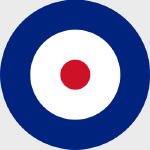Corgi AA36107 RCAF Consolidated IVA Catalina Flying Boat - JX580, No. 117 Squadron, Nova Scotia, Canada, 1942 (1:72 Scale)
"If a ship has been sunk, I can't bring it up. If it is going to be sunk, I can't stop it. I can use my time much better working on tomorrow's problem than by fretting about yesterday's. Besides, if I let those things get me, I wouldn't last long."
- USN Admiral Ernest J. King discussing the Trans-Atlantic convoy system, 1942
 The PBY Catalina was the US Navy designation for an American and Canadian-built flying boat of the 1930s and 1940s. PB stands for Patrol Bomber, with Y being Consolidated's manufacturer identification. It could be equipped with depth charges, bombs, torpedoes, and .50 caliber machine guns and was one of the most widely used multi-role aircraft of World War II. Catalinas served with every branch of the US military and in the air forces and navies of many other nations.
The PBY Catalina was the US Navy designation for an American and Canadian-built flying boat of the 1930s and 1940s. PB stands for Patrol Bomber, with Y being Consolidated's manufacturer identification. It could be equipped with depth charges, bombs, torpedoes, and .50 caliber machine guns and was one of the most widely used multi-role aircraft of World War II. Catalinas served with every branch of the US military and in the air forces and navies of many other nations.
In World War II, PBYs were used as anti-submarine warfare aircraft, patrol bombers, convoy escorts, search and rescue aircraft, and transports. The Catalina can be considered the most successful aircraft of its kind, as no other flying boat was produced in greater numbers. The last active military Catalinas were not retired from service until the 1980s. Even today, over seventy years after its first flight, the aircraft continues to fly as an airtanker in aerial firefighting operations all over the world.
The Catalina was originally designed to be a patrol bomber, an aircraft with a long operational range intended to locate and attack enemy transport ships at sea in order to compromise enemy supply lines. With a mind to a potential conflict in the Pacific Ocean, where troops would require resupply over great distances, the US Navy in the 1930s invested millions of dollars in developing long-range flying boats for this purpose. Flying boats had the advantage of not requiring runways to take off and land, in effect having the entire ocean available as its runway. Several different flying boats were adopted by the Navy, but the PBY Catalina was the most widely used and produced.
Although slow and ungainly, Catalinas distinguished themselves in World War II as exceptionally reliable aircraft. Allied armed forces used them successfully in a wide variety of roles that the aircraft was never intended for. They are remembered most by veterans of the war for their role as rescuing aircraft, where they saved the lives of thousands of aircrewmen shot down over the Pacific Ocean.
Pictured here is a 1:72 scale replica of a Royal Canadian Air Force Consolidated IVA Catalina flying boat that was attached to No.117 Squadron, then deployed to Nova Scotia, Canada, in 1942.
Sold Out!
Dimensions:
Wingspan: 17-1/4-inches
Length: 10-3/4-inches
Release Date: December 2008
Historical Account: "Guarding the New World" - Authorized as a Fighter unit at Saint John, New Brunswick, Canada on April 1st, 1938, the squadron was redesignated Coast Artillery Cooperation (CAC) on May 1st, 1939. When ordered to mobilize in September, the squadron's organization was incomplete and it was disbanded on October 29th, 1939.
Re-formed as a Bomber Reconnaissance unit at Sydney, Nova Scotia on August 1st, 1941 with Stranraer flying boats, the squadron, less aircraft, was transferred to Western Air Command in October; there its members were distributed among other under-strength units. The squadron was temporarily disbanded at Jericho Beach (Vancouver), British Columbia on November 20th, 1941.
Reactivated at Sydney on April 28th, 1942, the unit flew Catalina and Canso A aircraft on anti-submarine duty over the Gulf of St. Lawrence and the waters adjacent to Cape Breten Island until disbanded at Shelburne, Nova Scotia on December 15th, 1943.
JX580 was one of 12 Model 28 Catalina Mk.IVA in service with the RCAF from May 8th, 1943, to December 18th, 1946. It suffered a category 'C' accident at Patricia Bay, British Columbia on May 4th, 1945, and was subsequently struck off strength earlier than planned on September 4th, 1946.







